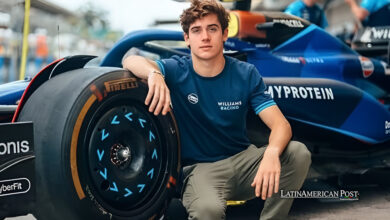Formula 1 2022: More Aerodynamic Autos Seeking Greater Parity
Many Changes were Introduced for the Current F1 Season in Which Five Grand Prix have Already been Held. Let's Review the Different Modifications in the Vehicles of this Campaign and the Scope of them..

Photo: Unsplash
LatinAmerican Post | Onofre Zambrano
Listen to this article
Leer en español: Fórmula Uno 2022: monoplazas más aerodinámicos que buscan mayor paridad
There are various changes that the Formula One autos have undergone in this still incipient 2022 season, modifications that have been studied since 2020 but that had not been applied due to the pandemic. The objectives are to balance the grid by reducing the marked differences that exist between three teams with the rest, to facilitate overtaking and to keep the show on the tracks.
However, it does not mean that Red Bull, Mercedes and Ferrari are going to decline significantly and go from being the three most dominant teams to the weakest, since other factors must be combined for that to happen, but it can be ensured that the remaining teams they will give them much more competition this campaign. The sports director of F1, Ross Brawn, said it well, according to El Periódico "We want and will have more wheel-to-wheel fights."
Something similar assured the Spanish Fernando Alonso, today an Alpine driver, when asked about a possible parity for this 2022. “After four or five races there will be one or two teams that win and the others will copy what they have. All cars will be the same.
Unequal competition
Until the exciting 2021 campaign in which the Dutchman Max Verstappen won his first title, the difference between some teams and the rest in Formula 1 lay in the "dirty air", the one that flutters in the car that is in the lead, and causes the escort cars to lose 35% of their aerodynamic load by going behind the car that is ahead.
This is further deepened if the distance between the leading car and the rest approaches 20 meters, measured from the front wing of the leading car to the front wing of the following single-seater. In some way, equality is sought from aerodynamics.
"We have had many years of collaboration between the FIA and Formula 1 to review the aerodynamics. All the effects of the car are designed to improve clean air. The objective of the car is that they can be followed closely, we want the best drivers to win. , but that the competition is tighter and that they fight wheel to wheel," Brawn continued in statements compiled by DAZN.com.
The changes
The first is the much-mentioned "ground effect" that serves to enhance overtaking, and which returns to the top flight 40 years after being banned in the 1982 season.
It is an aerodynamic concept that improves the grip of the single-seaters by taking advantage of the air current and directing it towards the lower part of the car towards the diffuser, and in short, it enhances overtaking. Thus, the cars can be closer without suffering the consequences of dirty air, overheating of the tires and loss of aerodynamic force.
But be careful that this first modification presents a handicap, which is the so-called "porpoise" because the single-seaters bounce at high speeds on the straight due to the fact that the spoiler touches the ground, and even if this is increased, the design of the entire car is affected.
Heavier cars but without paint
It's simple aerodynamics. The weight of the vehicles that compete this season went from 743 to 795 kilos, which gives the cars a larger size and a more robust appearance that does not slow them down at all, because even with greater weight they can generate better speed. The 'bargeboards' are eliminated and the DRS and the 'Halo' system that entered competition in 2018 with the aim of reinforcing the pilot's safety are maintained.
However, a close inspection of the cars at the Bahrain Grand Prix determined that several cars were missing paint in some areas and carbon fiber can be seen instead. The best example of this was that of McLaren, whose air intake went from being orange at the presentation of the car to being black after five races.
Another team on display was Aston Martin, which removed paint from some areas of its sidepod, showing just how far its determination to cut weight goes. In this regard, its technical director, Andy Green, told Motorsport: "Weight is a big problem because these cars are very heavy according to the regulations, and reducing the weight to the regulations is a challenge. We have revised the entire car, from the front to the back, and we have removed paint where we could. I think we have saved about 350 grams in total".
No one boosts engines
Very importantly, no team can boost its engine until the 2025 season, the year in which the arrival of a new generation of power units is expected, whose architecture is yet to be defined but which unofficially point to hybrid engines. Experts say that this new power will mainly help Mercedes, Honda, Ferrari and Renault, due to the characteristics of their engines.
Also read: Erling Haaland is already a citizen: a great resource for Manchester City
This year's F1 autos have already surprised with their deflectors on the tires, returning to an old design from the 2009 season and which are intended to send airflow through the wheels so that the cars increase their downforce. That seems to be the key word for this year: aerodynamics.
Sustainable and efficient
E10 fuel, featuring 10% sustainable ethanol, removes the limitations and teams will be able to consume more than 110kg of fuel per race. In this regard, Nikolas Tombazis, director of technology of the International Automobile Federation (FIA), spoke.
“We have worked to improve the carbon footprint, both in fuels and in parts. There is a lot of room for improvement for the sport to be sustainable. Many car parts are going to be cheaper and everything is going in that direction. From an engineering point of view, current engines are efficient, as they convert 50% of the fuel's energy into energy, which is much higher than any engine in the world. Efficiency and sustainability”, the FIA member explained to El Periódico.
Young pilots
Finally, the FIA compressed its weekend schedule to allow teams to arrive at the circuit a day later. Thus, the official press conferences were moved to Friday mornings and the free practice sessions to Friday afternoons. The body also wants to promote young drivers by forcing teams to use them for two Grands Prix.




